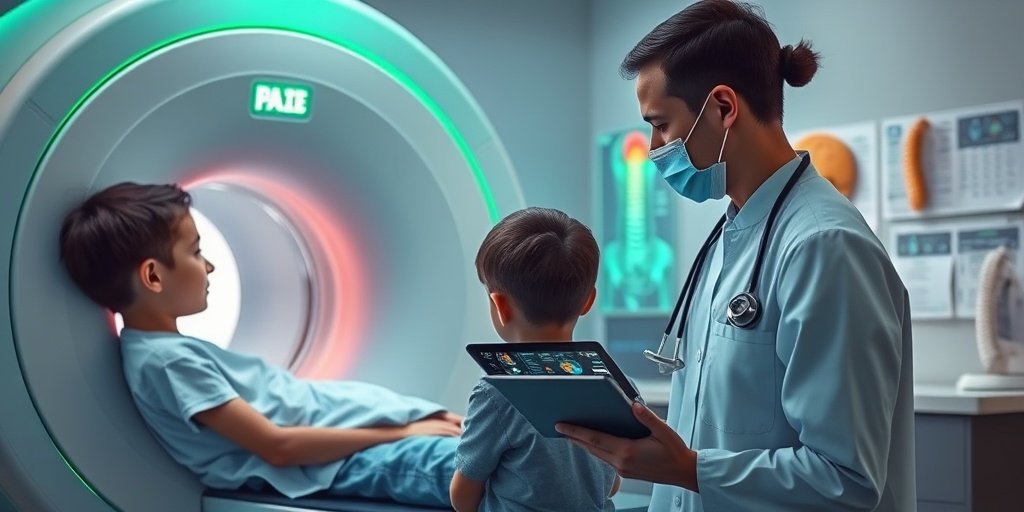⚡ Quick Summary
The article discusses Adolescent Lumbar Disc Herniation (ALDH), a condition with a rising incidence among adolescents, emphasizing the importance of timely diagnosis and appropriate treatment. It highlights the potential of regenerative medicine and AI technology in improving treatment outcomes for ALDH.
🔍 Key Details
- 📊 Incidence: ALDH is less common than adult lumbar disc herniation but is increasing yearly.
- 🧩 Etiology: Factors include trauma, genetics, immunity, developmental, and biomechanical abnormalities.
- ⚙️ Diagnosis: Similar to adults, with a notable 90% positive straight leg raising (SLR) test.
- 🏆 Imaging: Posterior apophyseal ring fracture (PARF) is a characteristic finding.
- 💊 Treatment: First-line treatment is conservative, with surgery as a last resort.
- 🔬 Advances: Regenerative medicine and spinal endoscopic operations are emerging as effective options.
- 🤖 AI Integration: AI may assist in treatment timing, surgical choices, and predicting complications.
🔑 Key Takeaways
- 📈 ALDH is on the rise among adolescents, necessitating increased awareness and research.
- 🩺 Timely diagnosis is crucial to mitigate psychological impacts on affected adolescents.
- 💡 Conservative treatment remains the first-line approach, though less effective than in adults.
- 🔍 Characteristic imaging findings can aid in accurate diagnosis.
- 🌱 Regenerative medicine is showing promise in treating ALDH.
- 🔧 Surgical techniques are evolving, with a shift towards less invasive options.
- 🤖 AI technology is expected to enhance decision-making in ALDH treatment.

📚 Background
Adolescent Lumbar Disc Herniation (ALDH) is a condition that, while less prevalent than its adult counterpart, is becoming increasingly recognized in clinical settings. The psychological ramifications of delayed diagnosis and treatment can be significant for adolescents, making it essential to understand the etiology and treatment options available.
🗒️ Study
The study conducted by Zhang et al. provides a comprehensive overview of ALDH, focusing on its etiology, diagnosis, and treatment options. It emphasizes the need for timely intervention and explores the role of emerging technologies in improving patient outcomes.
📈 Results
The findings indicate that while conservative treatment remains the primary approach, advancements in regenerative medicine and the adoption of spinal endoscopic surgery have shown promising results. The study also highlights the potential of AI technology in enhancing treatment strategies and predicting complications.
🌍 Impact and Implications
The implications of this research are profound, as it underscores the need for a shift in how we approach ALDH. By integrating regenerative medicine and AI technology, healthcare providers can offer more effective and personalized treatment options, ultimately improving the quality of life for adolescents suffering from this condition.
🔮 Conclusion
This study sheds light on the complexities of Adolescent Lumbar Disc Herniation and the evolving landscape of treatment options. As research continues to deepen our understanding of ALDH, the integration of innovative technologies like AI and regenerative medicine holds great promise for enhancing patient care and outcomes. Continued exploration in this field is essential for developing effective strategies to combat ALDH.
💬 Your comments
What are your thoughts on the advancements in treating Adolescent Lumbar Disc Herniation? We invite you to share your insights and experiences in the comments below or connect with us on social media:
Adolescent lumbar disc herniation: etiology, diagnosis, and treatment options.
Abstract
Adolescent lumbar disc herniation (ALDH) is a type of disease with a much lower incidence than adult lumbar disc herniation (LDH), which has a trend of increasing year by year. If the diagnosis is not timely or the treatment is not appropriate, it will have a serious impact on the adolescent’s psychology. The etiology of ALDH remains unclear, and it is thought that trauma, genetic, immunity, developmental abnormalities, and biomechanical abnormalities contribute to the onset and accelerate ALDH’s progression. The diagnosis of ALDH is similar to that of adults, but it has its characteristics, such as a positive straight leg raising (SLR) test in nearly 90% of patients, and posterior apophyseal ring fracture (PARF) is considered a characteristic imaging finding of ALDH. First-line treatment for ALDH remains conservative, although it is less effective than in adults. With the development of regenerative medicine, more and more treatment methods for small traumas have been applied to ALDH and achieved satisfactory treatment results. In the case of the above treatment, the effect is not satisfactory, surgery has become the last choice, different from the earliest use of open discectomy combined with fusion surgery, now more and more surgeries tend to use spinal endoscopic operation to solve, especially patients combined with some high-risk factors, and achieved satisfactory results. With the deepening of ALDH research, the etiology and mechanism of ALDH may be more fully understood. At the same time, with the development of Artificial intelligence (AI) technology, it is believed that in the near future, AI can provide references in the timing of conservative treatment for ALDH, the selection of surgical modalities, and the prediction of postoperative complications.
Author: [‘Zhang J’, ‘Zhang W’, ‘Yue W’, ‘Qin W’, ‘Li Z’, ‘Xu G’]
Journal: J Orthop Surg Res
Citation: Zhang J, et al. Adolescent lumbar disc herniation: etiology, diagnosis, and treatment options. Adolescent lumbar disc herniation: etiology, diagnosis, and treatment options. 2025; 20:605. doi: 10.1186/s13018-025-06024-3